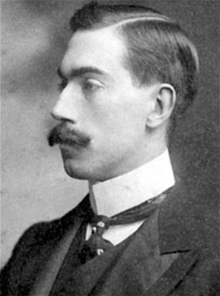
Leslie William Green was born at 99 Portsdown Road, London, England on 6 February 1875 and was the son of the architect Arthur William Green (1849-1904). After working as assistant to the Clerk of Works for King Street Chambers in London in 1891-92, he attended the South Kensington School of Art in 1892-93. He then worked in his father's office in London in 1893-94, following which he spent a year studying in Paris. He then returned to his father's office with whom he was articled from 1895 to 1897.
In 1897 he started his own independent architectural practice with offices at 11 Suffolk Street, London. He passed his qualifying examination in 1898 and in 1899 was elected an Associate of the Royal Institute of British Architects (ARIBA). In 1900 he moved his practice to 19 Haymarket and in 1903 to Adelphi House, 71 Strand, London. Later that year he became a member of the Architectural Association.
Between 1897 and 1903 Green worked on a range of architectural projects, none of which were of particular significance.
His breakthrough as an Architect came in 1903 when he was appointed Architect to the Underground Electric Railway Co. of London, working alongside Harry Wharton Ford (1875-1947), staff architect for the company. Over the next five years, Green was responsible for the design of over 50 stations on the Waterloo, Piccadilly and Northern Lines.
He was elected a Fellow of the Royal Institute of British Architects (FRIBA) in 1907. He exhibited once at the Royal Academy in London - designs for Oxford Circus Station, Baker Street and Waterloo Railway, in 1906.
Green contracted tuberculosis and died at a sanatorium in Mundesley-on-Sea, Norfolk on 31 August 1908. His address at the time of his death was 71 Strand, London.
He was succeeded as Architect to the Underground Electric Railway Co. of London by Stanley Arthur Heaps (1880-1962) who designed several more underground station much in the style of Green.
A biographical file on Leslie William Green is available at the Enquiry Desk, RIBA Library, London
Between 1897-1903: remodelling of a number of buildings including 81 Portland Place, 28 Sussex Square, and 26 Kensington Palace Gardens; and the construction of a residential block on the corner of St James's Street and Pall Mall, all in London.
Between 1903-1908: underground stations designed by Green included on the Bakerloo Line: Edgware Road; Great Central; Baker Street; Regent's Park; Oxford Circus; Piccadilly Circus; Trafalgar Square; Embankment; Kennington Road; and Elephant & Castle. On the Piccadilly Line: Gillespie Road; Holloway Road; Caledonian Road; York Road; King's Cross; Russell Square; Holborn; Strand; Covent Garden; Leicester Square; Piccadilly Circus; Dover Street; Down Street; Hyde Park Corner; Knightsbridge; Brompton Road; South Kensington; and Gloucester Road. On the Northern Line: Highgate; Tufnell Park; Kentish Town; South Kentish Town; Golders Green; Hampstead; Belsize Park; Chalk Farm; Camden Town; Mornington Crescent; Euston; Euston Road; Tottenham Court Road; Oxford Street; Leicester Square; and Charing Cross.
A number of these stations have subsequently been renamed and some have been demolished.
Directory of British Architects 1834-1914. Compiled by Antonia Brodie, et al. Volume 1: A-K. London; New York: British Architectural Library, Royal Institute of British Architects/Continuum, 2001
Gray, A. Stuart. Edwardian Architecture. A Biographical Dictionary. London: Gerald Duckworth, 1985
Leboff, David. The Underground Stations of Leslie Green. London: Capital Transport, 2002
‘Obituary’. The Builder vol. 95, 5 September 1908 p. 264
‘Obituary’. RIBA Journal vol. 15, 26 September 1908 p. 621